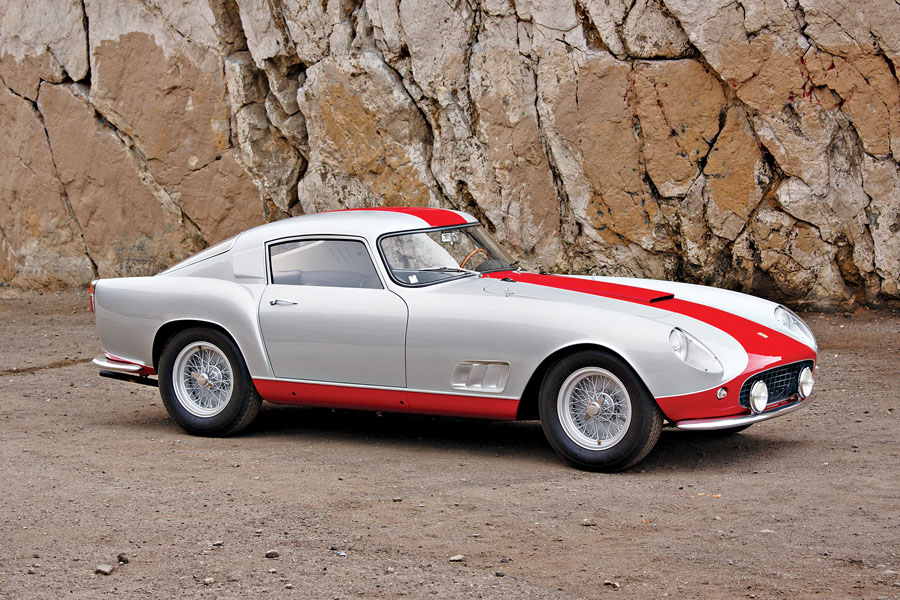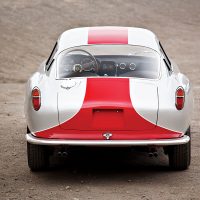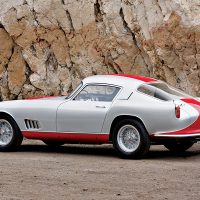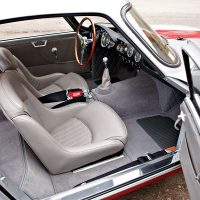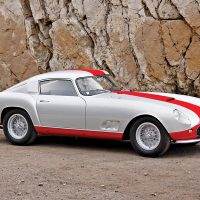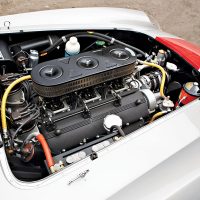SCM Analysis
Detailing
| Vehicle: | 1958 Ferrari 250 GT TdF Berlinetta by Scaglietti |
| Years Produced: | 1956–59 |
| Number Produced: | 77 or 78, depending on the source |
| Original List Price: | $12,000 |
| SCM Valuation: | $8,204,000 |
| Tune Up Cost: | $3,000 |
| Distributor Caps: | $450 |
| Chassis Number Location: | Left frame member by steering box |
| Engine Number Location: | Right rear motor mount |
| Club Info: | Ferrari Club of America |
| Website: | http://www.ferrariclubofamerica.org |
| Alternatives: | 1958 Mercedes-Benz 300SL, 1958 Ferrari California Spyder, 1960–63 Aston Martin DB4GT Zagato |
| Investment Grade: | A |
This car, Lot 17, sold for $5,100,000, including buyer’s commission, at Gooding & Company’s Pebble Beach Auction on August 16, 2019.
Excluding Formula One models, Ferrari production can be categorized into production cars and competition cars.
Up to chassis number 75,000, production cars are assigned odd-number chassis numbers while competition models are given an even chassis number. After chassis 75,000, odd and even numbers were used for both production and competition cars.
The division between production models and competition models can be pretty muddy. Competition models generally can be divided into Sports Competition, such as a 250 Testarossa, or Sports Prototype, such as a 330 P3.
Production models can be divided into production cars, such as a 275 GTB, or GT Competition cars, such as a 250 GTO. The 250 GT Tour de France falls into the latter category.
A new GT racing class
Following the deadly disaster at the 1955 24 hours of Le Mans, the racing sanctioning body, FIA, introduced a new racing class called GT. The class was intended for small-production Gran Turismo or Grand Touring cars built to be sold to the public for racing and road use.
There were several classes of GT cars, with the 3-liter class being the premier class.
The GT class was part of an international series of point races.
One of the races was the Tour de France. A grueling multi-day 6,000-plus-kilometer race (3,728-plus miles), the Tour de France challenged competitors to participate in hillclimbs and road-course races while they rallied throughout France.
Introduced in 1956 to participate in the 3-liter GT class, the 250 GT Tour de France was originally known only as a 250 GT. The organizers of the Tour de France allowed the manufacturer of the winning car to call the specific model a Tour de France.
Marquis Alfonso de Portago’s 1956 overall win in a 250 GT berlinetta allowed the model to use the TdF name. Overall wins during the next three years cemented the title to the model.
250 GT Ferraris would go on to be the overall winners of every Tour de France from 1956 to 1964.
Many variations
Not all Ferrari 250 GT Tour de France cars are the same. While it’s commonly known that the 14-louver examples are highly desirable, there can be other significant differences from car to car.
Some TdFs were delivered stripped and ready to race. Others were delivered with full carpet and prepared for a life as a sporty driver.
Engines came in different states of tune. Body styles could be significantly different, including examples with open headlamps, covered headlamps and Plexiglas headlamp shields.
Our subject TdF
Chassis 0903GT is an early example featuring covered headlamps and a single louver in the sail panel. The combination hovers near the middle of the TdF desirability chart. It was delivered new to a Swedish racer who hardly raced the car.
A DNF at the 1958 12 Hours of Reims is its major accolade. That’s a value ding for a model known for its racing prowess.
Prior to its 10th birthday, 0903GT ended up on its roof during a road accident. It was repaired and returned to service. While the model is known for being stout, 0903GT is reported to have had some frustrating engine issues along the way. At one time, it was disassembled and stored in boxes for three decades.
Once the boxes were recovered, the car received a top-quality restoration at a European restorer. In 2010, American Peter McCoy acquired the car. McCoy is a fellow IAC/PFA judge and a veteran of the concours scene. He sent the car to Motion Products for an update of the prior restoration, and $675,000 later it was ready for Pebble Beach.
Slipping in the market
When a car is auctioned, bidders determine its value right then and there. It takes two bidders to make a successful auction, and the more bidders, the better the results. If the second bidder drops out at a low price, the lot may be doomed. However, if two bidders are determined to buy the same lot, auction magic happens.
Gooding & Company has a world-class clientele. They have auction records in several categories. Their Pebble Beach Auction is one of the most respected in the genre. There are always large crowds and lots of money in the room. Few venues can match Gooding Pebble Beach for results.
Dual-purpose Ferrari 250 GT berlinettas are some of the most valuable cars ever produced, with a 250 GTO sale being the highest known auction sale of any automobile.
However, lately prices have been slipping.
The high-water mark for a 250 TdF was a $13.2 million sale in 2015. That was the actual Marquis de Portago 1956 Tour de France-winning car that the series was named for.
Subsequent auction sales are sparse, with one selling at $8.8 million in 2013 and another at $9.5 million in 2014. A year ago, a TdF sold for $6.6 million. Early this year, one sold for $5.9 million.
Too many auctions, too many cars
Gooding’s estimate for 0903GT was a tight $5.5 million to $6 million. The sale missed the lower estimate, but ultimately the car sold. This was a tough year at Monterey. Several big cars went home unsold. Others — like 0903GT — sold under the estimate.
Car collecting is a supply-and-demand business. A proliferation of auctions has brought a barrage of offerings to the market. The onslaught is desensitizing buyers and fostering apathy. A retreat in prices and the sting of losses taken by resellers of recent purchases has taken some of the fun out of collector-car speculating.
Collector-car bidders are starting to watch from the sideline and the gains of recent years are becoming a thing of the past. It may take the demise of an auction house or two before the market stabilizes. ♦
(Introductory description courtesy of Gooding & Company.)
